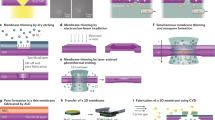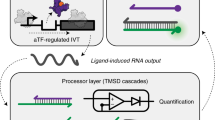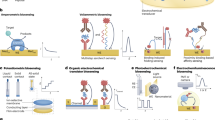Abstract
Electrochemistry-based sensors offer sensitivity, selectivity and low cost for the detection of selected DNA sequences or mutated genes associated with human disease. DNA-based electrochemical sensors exploit a range of different chemistries, but all take advantage of nanoscale interactions between the target in solution, the recognition layer and a solid electrode surface. Numerous approaches to electrochemical detection have been developed, including direct electrochemistry of DNA, electrochemistry at polymer-modified electrodes, electrochemistry of DNA-specific redox reporters, electrochemical amplifications with nanoparticles, and electrochemical devices based on DNA-mediated charge transport chemistry.
This is a preview of subscription content, access via your institution
Access options
Subscribe to this journal
Receive 12 print issues and online access
$209.00 per year
only $17.42 per issue
Buy this article
- Purchase on Springer Link
- Instant access to full article PDF
Prices may be subject to local taxes which are calculated during checkout







Similar content being viewed by others
References
Ramsey, M. DNA chips: state-of-the-art. Nat. Biotechnol. 16, 40–44 (1998).
Gooding, J.J. Electrochemical DNA hybridization biosensor Electroanalysis 14, 1149–1156 (2002).
Palecek, E. & Jelen, F. Electrochemistry of nucleic acids and development of DNA sensors. Crit. Rev. Anal. Chem. 3, 261–270 (2002).
Wang, J. Electrochemical nucleic acid biosensors. Anal. Chim. Acta 469, 63–71 (2002).
Fodor, S.P.A. DNA sequencing—massively parallel genomics. Science 277, 393–403 (1997).
Epstein, J.R., Biran, I. & Walt, D.R. Fluorescence-based nucleic acid detection and microarrays. Anal. Chim. Acta 469, 3–36 (2002).
Marshall, A. & Hodgson, J. DNA chips: an array of possibilities. Nat. Biotechnol. 16, 27–31 (1998).
Ji, J. & Manak, M. Genotyping of single nucleotide polymorphisms for epidemiological studies: a review of current methods. J. Clin. Ligand Assay 25, 199–210 (2002).
Broude, N.E. Stem-loop oligonucleotides: a robust tool for molecular biology and biotechnology. Trends Biotechnol. 20, 249–256 (2002).
Epstein, J.R., Leung, A.P.K., Lee, K.H. & Walt, D.R. High-density, microsphere-based fiber optic DNA microarrays. Biosensors Bioelectron. 18, 541–546 (2003).
Fryer, R.M. et al. Global analysis of gene expression: methods, interpretation, and pitfalls. Exp. Nephrol. 10, 64–74 (2002).
McDonnell, J.M. Surface plasmon resonance: towards an understanding of the mechanisms of biological molecular recognition. Curr. Opin. Chem. Biol. 5, 572–577 (2001).
Storhoff, J.J., Elghanian, R., Mucic, R.C., Mirkin, C.A. & Letsinger, R.L. One-pot colorimetric differentiation of polynucleotides with single base imperfections using gold nanoparticle probes. J. Am. Chem. Soc. 120, 1959–1964 (1998).
Taton, T.A., Mirkin, C.A. & Letsinger, R.L. Scanometric DNA array detection with nanoparticle probes. Science 289, 1757–1760 (2000).
Wang, J., Jiang, M. & Palecek, E. Real-time monitoring of enzymatic cleavage of nucleic acids using a quartz crystal microbalance. Bioelectrochem. Bioenergetics 4, 477–480 (1999).
Patolsky, F., Lichtenstein, A. & Willner, I. Electronic transduction of DNA sensing processes on surfaces: amplification of DNA detection and analysis of single-base mismatches by tagged liposomes. J. Am. Chem. Soc. 123, 5194–5205 (2001).
Fritz, J. et al. Translating biomolecular recognition into nanomechanics. Science 288, 316–318 (2000).
Wang, J. Portable electrochemical systems. Trends Anal. Chem. 21, 226–232 (2002).
Palecek, E. Oscillographic polarography of highly polymerized deoxyribonucleic acid. Nature 188, 656–657 (1960).
Palecek, E. Adsorptive transfer stripping voltammetry—determination of nanogram quantities of DNA immobilized at the electrode surface. Anal. Biochem. 170, 421–431 (1988).
Singhal, P. & Kuhr, W.G. Ultrasensitive voltammetric detection of underivatized oligonucleotides and DNA. Anal. Chem. 69, 4828–4832 (1997).
Jelen, F., Yosypchuk, B., Kourilova, A., Novotny, L. & Palecek, E. Label-free determination of picogram quantities of DNA by stripping voltammetry with solid copper amalgam or mercury electrodes in the presence of copper. Anal. Chem. 74, 4788–4793 (2002).
Wang, J. & Kawde, A.B. Amplified label-free electrical detection of DNA hybridization. Analyst 127, 383–386 (2002).
Ozkan, D. et al. Allele-specific genotype detection of factor V Leiden mutation from polymerase chain reaction amplicons based on label-free electrochemical genosensor. Anal. Chem. 74, 5931–5936 (2002).
Kerman, K. et al. Label-free bioelectronic detection of point mutation by using peptide nucleic acid probes. Electroanalysis 15, 667–670 (2003).
Yang, I.V. & Thorp, H.H. Modification of indium tin oxide electrodes with repeat polynucleotides: electrochemical detection of trinucleotide repeat expansion. Anal. Chem. 73, 5316–5322 (2001).
Armistead, P.M. & Thorp, H.H. Electrochemical detection of gene expression in tumor samples: overexpression of RAK nuclear tyrosine kinase. Bioconj. Chem. 13, 172–176 (2002).
Yang, I.V., Ropp, P.A. & Thorp, H.H. Toward electrochemical resolution of two genes on one electrode: using 7-deaza analogues of guanine and adenine to prepare PCR products with differential redox activity. Anal. Chem. 74, 347–354 (2002).
Palecek, E., Fojta, M. & Jelen, F. New approaches in the development of DNA sensors: hybridization and electrochemical detection of DNA and RNA at two different surfaces. Bioelectrochemistry 56, 85–90 (2002).
Fojta, M. et al. Two-surface strategy in electrochemical DNA hybridization assays: detection of osmium-labeled target DNA at carbon electrodes. Electroanalysis 15, 431–440 (2003).
Umek, R.M. et al. Electronic detection of nucleic acids—a versatile platform for molecular diagnostics. J. Mol. Diag. 3, 74–84 (2001).
Yu, C.J. et al. Electronic detection of single-base mismatches in DNA with ferrocene-modified probes. J. Am. Chem. Soc. 123, 11155–11161 (2001).
Ozsoz, M. et al. Electrochemical genosensor based on colloidal gold nanoparticles for the detection of Factor V Leiden mutation using disposable pencil graphite electrodes. Anal. Chem. 75, 2181–2187 (2003).
Wang, J., Liu, G.D. & Merkoci, A. Electrochemical coding technology for simultaneous detection of multiple DNA targets. J. Am. Chem. Soc. 125, 3214–3215 (2003).
Willner, I. & Willner, B. Functional nanoparticle architectures for sensoric, optoelectronic, and bioelectronic applications. Pure Appl. Chem. 74, 1773–1783 (2002).
Campbell, C.N., Gal, D., Cristler, N., Banditrat, C. & Heller, A. Enzyme-amplified amperometric sandwich test for RNA and DNA. Anal. Chem. 74, 158–162 (2002).
Dequaire, M. & Heller, A. Screen printing of nucleic acid detecting carbon electrodes. Anal. Chem. 74, 4370–4377 (2002).
Patolsky, F., Katz, E. & Willner, I. Amplified DNA detection by electrogenerated biochemiluminescence and by the catalyzed precipitation of an insoluble product on electrodes in the presence of the doxorubicin intercalator. Angew. Chem. Int. Edn. 41, 3398–3402 (2002).
Patolsky, F., Lichtenstein, A. & Willner, I. Highly sensitive amplified electronic detection of DNA by biocatalyzed precipitation of an insoluble product onto electrodes. Chem. Eur. J. 9, 1137–1145 (2003).
Wang, J., Kawde, A.N., Musameh, M. & Rivas, G. Dual enzyme electrochemical coding for detecting DNA hybridization. Analyst 127, 1279–1282 (2002).
Millan, K.M. & Mikkelsen, S.R. Sequence-selective biosensor for DNA-based on electroactive hybridization indicators. Anal. Chem. 65, 2317–2323 (1993).
Steel, A.B., Herne, T.M. & Tarlov, M.J. Electrochemical quantitation of DNA immobilized on gold. Anal. Chem. 70, 4670–4677 (1998).
Boon, E.M. & Barton, J.K. Charge transport in DNA. Curr. Opin. Struct. Biol. 12, 320–329 (2002).
Kelley, S.O., Barton, J.K., Jackson, N.M. & Hill, M.G. Electrochemistry of methylene blue bound to a DNA-modified electrode. Bioconj. Chem. 8, 31–37 (1997).
Kelley, S.O., Jackson, N.M., Hill, M.G. & Barton, J.K. Long-range electron transfer through DNA films. Angew. Chem. Int. Edn. 38, 941–945 (1999).
Boon, E.M., Ceres, D.M., Drummond, T.G., Hill, M.G. & Barton, J.K. Mutation detection by electrocatalysis at DNA-modified electrodes. Nat. Biotechnol. 18, 1096–1100 (2000).
Kelley, S.O., Boon, E.M., Barton, J.K., Jackson, N.M. & Hill, M.G. Single-base mismatch detection based on charge transduction through DNA. Nucleic Acids Res. 27, 4830–4837 (1999).
Ozsoz, M., Erdem, A., Kara, P., Kerman, K. & Ozkan, D. Electrochemical biosensor for the detection of interaction between arsenic trioxide and DNA based on guanine signal. Electroanalysis 15, 613–619 (2003).
Cady, N., Stelick, S. & Batt, C.A. Nucleic acid purification using microfabricated silicon structures. Biosensors Bioelectron. (in press).
Boon, E.M., Salas, J.E. & Barton, J.K. An electrical probe of protein–DNA interactions on DNA-modified surfaces. Nat. Biotechnol. 20, 282–286 (2002).
Grody, W.W. et al. Laboratory standards and guidelines for population-based cystic fibrosis carrier screening. Genetics Med. 3, 149–154 (2001).
Heller, A. Plugging metal connectors into enzymes. Nat. Biotechnol. 21, 631–632 (2003).
Wang, J., Xu, D.K., Kawde, A.N. & Polsky, R. Metal nanoparticle-based electrochemical stripping potentiometric detection of DNA hybridization. Anal. Chem. 73, 5576–5581 (2001).
Wang, J., Polsky, R. & Xu, D.K. Silver-enhanced colloidal gold electrochemical stripping detection of DNA hybridization. Langmuir 17, 5739–5741 (2001).
Wang, J., Xu, D.K. & Polsky, R. Magnetically-induced solid-state electrochemical detection of DNA hybridization. J. Am. Chem. Soc. 124, 4208–4209 (2002).
Park, S.J., Taton, T.A. & Mirkin, C.A. Array-based electrical detection of DNA with nanoparticle probes. Science 295, 1503–1506 (2002).
Wang, J., Polsky, R., Merkoci, A. & Turner, K.L. “Electroactive beads” for ultrasensitive DNA detection. Langmuir 19, 989–991 (2003).
Acknowledgements
We are grateful to the National Institutes of Health for their financial support of our research.
Author information
Authors and Affiliations
Corresponding author
Rights and permissions
About this article
Cite this article
Drummond, T., Hill, M. & Barton, J. Electrochemical DNA sensors. Nat Biotechnol 21, 1192–1199 (2003). https://doi.org/10.1038/nbt873
Issue Date:
DOI: https://doi.org/10.1038/nbt873
This article is cited by
-
Development of biosensors for detection of fibrinogen: a review
Analytical and Bioanalytical Chemistry (2024)
-
Cell phone microscopy enabled low-cost manufacturable colorimetric urine glucose test
Biomedical Microdevices (2023)
-
The effect of preparation conditions of chalcone based benzoxazine/magnetite nanocomposites on magnetization properties
Journal of Polymer Research (2023)
-
Electrochemical DNA Sensor Designed Using the Pencil Graphite Electrode to Detect Listeria monocytogenes
Applied Biochemistry and Biotechnology (2023)



